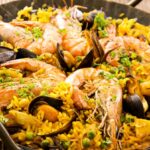Seafood Paella
Rice
When asked what the most important ingredient is in any paella dish, the answer will always be paella rice. Whichever rice you use it should be an absorbent, short- or medium-grain rice, never ever long-grain. Short-grain rice can absorb more liquid before becoming mushy, making it possible to achieve the perfect, dry texture.
Seafood
Oysters, clams, and mussels are always a good start. You can use just about any seafood you would like. The key is to time the cooking to finish as the rice is done. In order to achieve this goal, I like to par-cook or pre-cook the items that need more time, such as shellfish and lobster. Fish fillets can usually cook in the pan. I like snails, when available. Even canned escargot introduced to the party at the end can lend interest to the presentation.
Seafood Paella
What You Will Need:
- 1 large onion - finely chopped white or sweet onion
- 5 tablespoons olive oil - extra virgin
- 2 cloves garlic - crushed to a paste or finely chopped
- 2 whole tomatoes - fresh or canned, peeled and chopped
- 1/2 teaspoon sugar - as needed
- Salt - to taste
- 1 teaspoon pimentón dulce - or sweet paprika
- 1 pinch saffron threads
- 4 small squid - cleaned, bodies sliced into 1/4-inch-wide rings, tentacles left whole
- 2 cups medium-grain Spanish paella rice or risotto rice - such as Arborio or Carnaroli
- 3 cups fish or chicken stock - plus more if needed
- 1 cup dry white wine - or more to drink
- 12 jumbo shrimp in their shells - 16/20 size
- 2 lbs mussels - in shells, scrubbed and debearded
Equipment Needed:
- 14-16" paella pan
Method:
- Fry the onion in the oil in a 16-inch paella pan until soft, stirring often.
- Stir in the garlic, and before it begins to color, add the tomatoes.
- Add the sugar, salt to taste, pimentón (or paprika), and saffron, stir well, and cook until the tomatoes are reduced to a jammy sauce and the oil is sizzling.
- Add the squid and cook, stirring, for a minute or so.
- Add the rice and stir well until all the grains are coated. (You can prepare the dish to this point up to an hour in advance.)
- Bring the stock and wine to a boil in a saucepan. Pour over the rice, bring to a boil, and add salt to taste (even if the broth tastes a bit salty, it will not be salty when it is absorbed by the rice). Stir well and spread the rice out evenly in the pan (do not stir again). Cook the rice over low heat for 18 to 20 minutes, moving the pan around and rotating it so that the rice cooks evenly.
- Lay the shrimp on top after 10 minutes and turn them when they have become pink on the first side. Add a little more hot stock toward the end if the rice seems too dry and you hear crackly frying noises before it is done. When the rice is done, turn off the heat and cover the pan with a large piece of foil.
- Steam the mussels with a finger of water in a pan with a tight-fitting lid. As soon as they open, they are cooked. Throw away any that have not opened.
- Arrange the mussels on top of the paella.
Variations
- •Add 4 quartered small artichoke hearts or bottoms, fresh or defrosted frozen, a good handful of peas, green beans or broad beans cut into short lengths, or roasted red peppers, cut into strips, with the rice.
- •In Alicante, they use the pulp of 1 or 2 dried and soaked ñora peppers, which they grow, instead of pimentón.
- •Use clams instead of mussels.
- •You can make this into an arroz caldoso, or soupy rice, by adding 1 more cup of boiling stock, but do not cook it for any longer or the rice will be soggy.
- •If you want to use lobster, ask the fishmonger to cut a live lobster into pieces. Boil it for minutes only, until it turns red. Or boil it whole and cut it up.
Notes
•Add 4 quartered small artichoke hearts or bottoms, fresh or defrosted frozen, a good handful of peas, green beans or broad beans cut into short lengths, or roasted red peppers, cut into strips, with the rice.
•In Alicante, they use the pulp of 1 or 2 dried and soaked ñora peppers, which they grow, instead of pimentón.
•Use clams instead of mussels.
•You can make this into an arroz caldoso, or soupy rice, by adding 1 more cup of boiling stock, but do not cook it for any longer or the rice will be soggy.
•If you want to use lobster, ask the fishmonger to cut a live lobster into pieces. Boil it for minutes only, until it turns red. Or boil it whole and cut it up.


